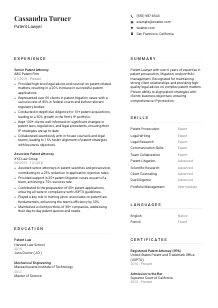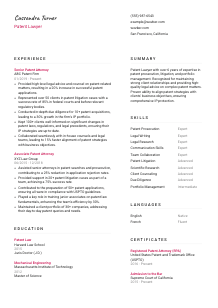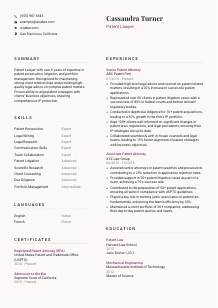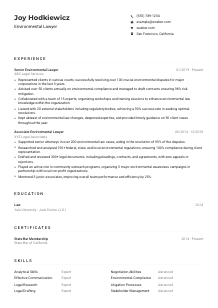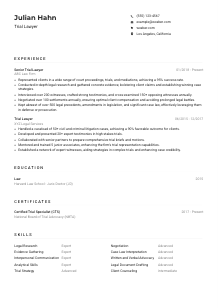Patent Lawyer Resume Example
Navigating intellectual rapids, but your resume is patently lacking? Dive into this Patent Lawyer resume example, formulated using Wozber free resume builder. Grasp how to present your legal acumen and inventive insights to match job specifications, positioning yourself at the forefront of career innovation!

How to write a Patent Lawyer Resume?
Welcome, future legal maven! As a Patent Lawyer gearing up to navigate the patent law waters, your resume isn't just a formal document; it's your personal beacon, guiding hiring managers through your wealth of expertise and achievements. With the legal industry's competitive landscape, standing out is paramount. Here, we embark on a deep dive into tailoring a resume that resonates with the essence of a Patent Lawyer, employing the advanced tools of Wozber's free resume builder.
This journey is designed to sculpt your resume into a narrative so compelling, it not only ticks all the boxes for Applicant Tracking Systems (ATS) but also showcases your unparalleled acumen in patent law. Let's set sail and chart the course to your next career milestone!
Personal Details
Your personal information is the herald of your professional story. Crafting this section for a Patent Lawyer position demands precision and alignment with the role's specifics. By focusing on the essentials and infusing markers that resonate with the Patent Lawyer domain, you create a strong first impression that's ATS-compliant, immediately drawing the hiring manager's attention.
1. Your Name as Your Brand
Your name is more than a mere identifier; it's your professional brand. Present it boldly at the top of your resume, using a clear, readable font. Consider it your headline, setting the tone for the story that unfolds.
2. Job Title Precision
Immediately below your name, articulate the title you're aspiring to - "Patent Lawyer." This strategic placement not only clarifies your professional aim but also aligns with the specific job posting, signaling to the ATS and hiring manager your targeted intent.
3. Essential Contact Details
Provide your most current phone number and a professional email address, ideally in the format firstname.lastname@email.com. In today's digital age, considering adding a LinkedIn profile can provide a comprehensive view of your professional landscape, ensuring it's reflective of your resume and optimized for networking.
4. Geographical Alignment
Since the position requires being located in or willing to relocate to San Francisco, California, stating your address or willingness to relocate in this area demonstrates your alignment with the role's logistical requirements, subtly addressing one less concern for the employer.
5. Digital Professionalism
If relevant, include your professional website or portfolio, especially if it showcases patents you've worked on or relevant publications. In the digital age, a well-curated professional online presence can significantly enhance your application.
Takeaway
Your personal introduction sets the stage for your professional narrative. It's crucial to align each detail with the Patent Lawyer role, crafting it as a clear, professional, and strategic entry point into your resume. Remember, these initial lines are more than mere formalities; they serve as a handshake, offering the most pivotal insights about you. With precision and alignment, you're ready to captivate from the get-go.





Experience
The experience section is your arena, where you demonstrate your prowess in the patent law battlefield. From patent searches to litigation victories, this section should narrate your journey as a Patent Lawyer, underscoring successes that mirror the job requirements meticulously. Emphasizing targeted accomplishments and equipping them with quantifiable evidence cultivates an image of a seasoned warrior in the legal domain.
- Provided high‑level legal advice and counsel on patent‑related matters, resulting in a 20% increase in successful patent applications.
- Represented over 50 clients in patent litigation cases with a success rate of 85% in federal courts and before relevant regulatory bodies.
- Conducted in‑depth due diligence for 10+ patent acquisitions, leading to a 30% growth in the firm's IP portfolio.
- Kept 100+ clients well‑informed on significant changes in patent laws, regulations, and legal precedents, ensuring their IP strategies are up‑to‑date.
- Collaborated seamlessly with in‑house counsels and legal teams, leading to 15% faster alignment of patent strategies with business objectives.
- Assisted senior attorneys in patent searches and prosecution, contributing to a 25% reduction in application rejection rates.
- Provided support in 20+ patent litigation cases as part of a team, achieving a 75% success rate.
- Contributed to the preparation of 50+ patent applications, ensuring all were in compliance with USPTO guidelines.
- Played a key role in training junior associates on patent law fundamentals, enhancing the team's efficiency by 30%.
- Maintained a client portfolio of 30+ companies, addressing their day‑to‑day patent queries and needs.
1. Dissecting the Battlefield
Begin by dissecting the job posting, highlighting keywords and requirements such as "patent prosecution" and "patent litigation." These terms are your north star, guiding the articulation of your responsibilities and achievements in the experience section.
2. Chronological Triumphs
Lay out your professional timeline, starting with your most recent positions. For each role, include your title, the firm or organization, and your tenure dates. A clear, chronological format allows the hiring manager to easily navigate through your career trajectory.
3. Victories and Achievements
Under each role, delve into your specific achievements. Tailor these to the job description, such as detailing how you "Provided high-level legal advice on patent-related matters, resulting in a 20% increase in successful patent applications." Quantifying your success not only highlights your competency but also gives a tangible measure of your impact in the field.
4. The Power of Quantification
Whenever possible, quantify your achievements. Whether it's the number of patent cases won, the percentage increase in successful patent applications, or the growth of a firm's IP portfolio under your guidance, tangible metrics add weight to your claims and set you apart as a candidate.
5. Relevance is Key
Maintain a laser focus on experiences relevant to the Patent Lawyer role. Trim any fluff or unrelated achievements, no matter how proud you might be of them. Each line should contribute directly to painting a picture of you as the ideal candidate for the job described.
Takeaway
The experience section is a chronicle of your legal battles, showcasing your expertise and victories as a Patent Lawyer. Tailor each point, keep the narrative relevant, and provide quantitative evidence of your impact. This is your opportunity to demonstrate not just that you're qualified, but that you're a master of the craft. Let your career timeline recount tales of victory and skill.
Education
The education section of your resume is the foundation upon which your legal expertise is built. For a Patent Lawyer, showcasing a robust legal and technical background is imperative. Tailoring your education to reflect the specific demands of the role, such as holding a Juris Doctor (J.D.) degree and a strong technical background, reinforces your qualification for the position.
1. Unearthing Educational Gems
Identify and list your educational qualifications that directly address the job's requirements. For instance, underscore your "Juris Doctor (J.D.) degree from an accredited law school" and if applicable, a "Bachelor's or Master's degree in a relevant scientific or engineering field," exactly as mentioned in the job description.
2. A Clear and Concise Presentation
Present your educational background in a simple, straightforward manner. Start with your highest degree of education, followed by the field of study, the institution's name, and your graduation year. This clarity and structure facilitate an immediate grasp of your academic credentials.
3. Degree Specification
When the role specifically demands degrees in particular fields, as is often the case in Patent Law, ensure these are prominently listed. Highlight any specialization within your J.D. program that aligns with patent law, alongside your technical or scientific degrees, to underscore your fit for the role.
4. Relevant Courses and Achievements
While the broader degrees might cover the essentials, spotlighting relevant courses or achievements can add depth. Mention patent law-specific coursework, moot court successes, or related law review publications, especially if you're early in your career or the role leans towards a niche area within patent law.
5. Additional Educational Milestones
Highlighting other relevant legal accolades or involvement, such as certifications from recognized patent law workshops or active memberships in legal societies, can provide a more dynamic view of your educational journey. Though less crucial for senior roles, these details can enrich the narrative of a mid-level candidate.
Takeaway
Your education section should serve as a testament to your readiness and qualification for the Patent Lawyer role. By focusing on the specifics required by the job description and organizing the information clearly, you not only fulfill the basic criteria but also craft a narrative of a well-prepared legal professional poised for challenges in the patent law arena.
Certificates
In the high-stakes world of patent law, certifications can serve as the cherry on top of your resume, providing concrete evidence of your specialized knowledge and commitment to your craft. While the job description may not list specific certifications, highlighting relevant ones can significantly bolster your application.
1. Identifying Relevant Certifications
Start by assessing the job description for any mentioned certifications. Even in their absence, certifications like "Registered Patent Attorney (RPA)" from the United States Patent and Trademark Office (USPTO), as listed in our resume example, underscore your legitimate standing and specialized expertise in the field.
2. Cherry-pick Your Certifications
Select certifications that resonate most with the role's requirements and the broader field of patent law. This isn't about showcasing every certificate you've ever earned but about highlighting those that reinforce your qualifications for this specific position.
3. Date Matters
When listing certifications, including the date of acquisition or validity period is vital, especially for those that require renewal. This information attests to your up-to-date knowledge and ongoing commitment to professional development.
4. Continuous Learning
The legal field, as with many professional fields, is ever-evolving. Demonstrate your commitment to staying ahead of the curve by pursuing and listing current certifications, especially those that align with patent law advancements, technology trends, and professional best practices.
Takeaway
Certificates are more than accolades; they are markers of your dedication to excellence and continuous improvement in the realm of patent law. Choose them wisely, present them clearly, and keep seeking opportunities to learn and grow. This section is a testament to your commitment and a beacon for hiring managers looking for candidates who go above and beyond.
Skills
The skills section is your arsenal, a compact display of the tools at your disposal. In the context of a Patent Lawyer, determining the mix of hard and soft skills that the role demands and presenting them succinctly is crucial. This section is about showcasing your readiness and compatibility with the job requirements in a straightforward, ATS-compliant manner.
1. Dissecting the Job's DNA
Kickstart by extracting the skills directly mentioned in the job description, such as "patent prosecution," "legal research," and "communication skills." These serve as your keywords, essential for ATS optimization and demonstrating your relevance.
2. Curating Your Toolkit
With the job requirements as your guide, curate a list of your skills that match. Include a mix of hard skills, like "patent litigation," and soft skills, like "team collaboration." Be selective; focus on the skills that best represent your expertise and align with what the role calls for.
3. Presentation Is Everything
List your skills in a clean and organized manner, preferably in a bullet-point format for easy readability. While it might be tempting to list all your capabilities, prioritizing those that are most pertinent and reflective of the job description ensures a targeted and impactful section.
Takeaway
Thoughtfully curating your skills section is crucial in painting a picture of a well-rounded, highly competent professional, adept not only in the technical aspects of patent law but also in the necessary soft skills for effective collaboration and communication. Each skill you list bolsters your profile, pegging you as a prime candidate for the role. Walk the line between comprehensive and concise meticulously, and let your skills shine!
Languages
For a Patent Lawyer, adeptness in multiple languages can be a distinct advantage, particularly in the global arena of intellectual property law. This section delves into showcasing your linguistic capabilities, keeping in mind the role's specific requirements and the broader scope it might entail.
1. Check the Job's Linguistic Pulse
Start by reviewing if the job posting specifies any language requirements or preferences. The ability to "express oneself clearly in English" was a prerequisite for our role. This should be the primary language you list, marked as 'Native,' aligning with the job's requirements.
2. Prioritize and Position
If you speak additional languages, especially ones relevant to patent law on an international level, list these next. Position your language proficiency in a way that complements your role as a Patent Lawyer, potentially dealing with international clients or documentation.
3. Honest Assessment of Proficiency
Be honest about your level of fluency. Employers appreciate transparency, and overestimating your language skills can lead to uncomfortable situations. Use terms like 'Fluent,' 'Intermediate,' or 'Basic' to provide a clear picture of your capabilities.
4. The Added Value of Diversity
Additional languages may not be explicitly required, but they signify your ability to navigate a diverse and global legal landscape. Highlighting these skills can set you apart as a well-rounded candidate, prepared for the international complexities of patent law.
5. The Global Patent Lawyer
Consider your role's scope: if it involves international markets or working across borders, showcasing your multilingual abilities becomes even more critical. It portrays you as a global citizen, ready to engage with clients and colleagues worldwide.
Takeaway
In the world of patents, where details matter and communication is key, your language skills are indeed an asset, offering a bridge to international clients and enhancing your professional versatility. Whether you're navigating patent documentation in multiple languages or engaging with a global clientele, your linguistic capabilities enrich your profile, making you a more compelling candidate for the role.
Summary
The summary section is where you distill your professional essence into a few potent lines. For a Patent Lawyer, this means intertwining your legal acumen with your technical savvy, setting the stage for the detailed achievements that follow within the resume. A well-crafted summary is your pitch, your chance to grab attention and make a compelling case for why you're the ideal candidate for the role.
1. Grasping the Role's Core
First, immerse yourself in the essence of the role. Understand the key attributes the job requires and reflect on how your journey aligns with these. For a Patent Lawyer, this means highlighting your experience in "patent prosecution," "litigation," and strategic IP alignment.
2. A Potent Opening
Start your summary with a declarative introduction of your professional identity. "Patent Lawyer with over 6 years of expertise" sets the tone, framing you as an experienced legal professional ready to tackle the challenges of the role.
3. Echo the Role's Demands
Weave in a selection of your most pertinent skills and achievements that resonate with the job description. This isn't just about listing your qualifications; it's about narrating your unique contribution and the impact you've made in the field of patent law.
4. The Art of Brevity
Keep your summary concise, targeting 3-5 impactful lines. This section is your elevator pitch, not the full journey. Craft each sentence to pique interest and invite the hiring manager to delve deeper into your resume.
Takeaway
In the ancient halls of law, your summary is akin to your opening argument—an opportunity to captivate and convince. Tailored effectively to the Patent Lawyer role, it signals your fit and readiness, setting a compelling precedent for the rest of your resume. Let it be the light that guides hiring managers, marking the path to discovering your profound capabilities. Craft it with care, for it opens the gates to your future successes.
Embarking on Your Intellectual Quest
As our journey concludes, you're now equipped with the knowledge to tailor a resume that not only meets the stringent requirements of ATS systems but also showcases your unique talents and expertise as a Patent Lawyer. By utilizing Wozber's free resume builder, complete with ATS-friendly resume templates, and optimizing every section with the dedicated ATS resume scanner, you have at your disposal a powerful toolkit to carve out your niche in the competitive legal arena. Your resume is more than a document; it's a narrative of your professional conquests and aspirations. Refine it, make it resonate with your personal brand, and let it be the launchpad for your next career achievement.
The realm of patent law awaits your brilliance. Forge ahead and leave an indelible mark on the world!

- Juris Doctor (J.D.) degree from an accredited law school.
- Admission to the state bar and in good standing with the ability to practice law in Patent and Trademark Office (USPTO).
- Minimum of 5 years of experience in patent prosecution, patent litigation, or related patent law experience.
- Strong technical background in a relevant scientific or engineering field, preferably holding a Bachelor's or Master's degree.
- Excellent communication skills, both written and verbal, with the ability to explain complex legal matters to non-legal professionals.
- Ability to express oneself clearly in English is required.
- Must be located in or willing to relocate to San Francisco, California.
- Provide legal advice and counsel on patent-related matters, including patent searches, preparation, and prosecution.
- Represent clients in patent litigation, both in federal courts and before relevant regulatory bodies.
- Conduct due diligence for patent acquisitions, licensing, and portfolio management.
- Stay updated on changes in patent laws, regulations, and legal precedents, and keep the clients informed.
- Collaborate with in-house counsel, clients, and team members to ensure patent strategies align with business objectives.





